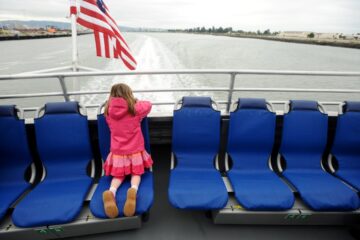Mayor London Breed to Bring Back the Barbary Coast?

The future of downtown San Francisco has been a touchy subject since COVID gutted the city’s financial core.
Mayor Breed’s newest revitalization scheme involves bringing an entertainment district á la New Orleans’ Bourbon Street to the Financial District. Another gambit to jumpstart downtown San Francisco, at least this idea doesn’t yearn for the dead-and-gone. Even Breed knows office culture is never coming back. Her plan shifts focus from daytime to nighttime occupancy, and she’s vying for the holy grail of nightlife: open-air consumption.
It’s a method that’s worked for struggling downtowns across the nation, especially the South and Midwest. I doubt San Francisco’s ever seen the need for such tactics, which explains why it took time to consider them. Senator Scott Weiner could be credited as being first to endorse open-air consumption policies. Last year’s bill, SB76, was his doing. Bars in San Francisco may now sell booze outdoors, but only during events the Department of Alcoholic Beverage Control approves.
Breed’s plan would experiment with what one bar owner calls a “more European” approach. “We could transform parts of the city into places that have a more European feel,” Ben Bleiman told the Chronicle. Mr. Bleiman owns Harrington’s Bar & Grill, situated along the Front Street corridor Mayor Breed is proposing. “You can walk outside with a beer and sit at a table…and not feel like you’re breaking the law.”
Downtown Revitalization: It’s been done.
Downtown revitalization is not new. I might say the first modern push to regenerate a struggling city’s core happened in New York in the seventies. That ad campaign, responsible for the iconic “I ❤ NY,” was successful for reasons beyond creative sloganeering. It invited the globe to embrace New York as a world-class city and most importantly, it didn’t leave out New Yorkers.
The people of New York define that city. Without them it’s inert, lifeless, hollow as a honeycomb empty of bees. It doesn’t matter to London Breed who retakes downtown. As long as they spend money and leave with a better impression that they arrived with. Tell your friends! Mayor Breed’s plans for Front Street might be making a critical mistake by overlooking San Francisco residents yet again.
I’m reminded of Kansas City, Missouri, where I grew up. The first time I saw downtown was from the backseat of my mother’s Hyundai. I was ten. She’d gotten a job in the city and my stepfather wanted to drive the route from the suburbs with her. The skyscrapers made me feel like we were in New York. The adults laughed, having visited the Big Apple. They saw the Twin Towers when they were new. The tallest building in Kansas City was and still is forty-two stories.
Open-air consumption is not a crime, but selling out your city should be.
At nineteen, I left my mother’s trailer and moved into a refurbished loft in downtown Kansas City. My junior one-bedroom apartment offered over eight hundred square feet for a whopping $585 a month. Not a single place I’ve rented since has measured up. My little crash pad was a stoner’s paradise. Once the daytime crowd rushed back home, the scene outside my sixth-floor windows fell quiet. Downtown at night felt like a movie set for a city instead of its real-life counterpart.
I loved it no less and did not believe it would change too much. In the late aughts, Kansas City handed the keys to downtown over to the Cordish Company. The developers had rejuvenated many central business districts-in-distress: Louisville, Charleston, Jacksonville and their home base Baltimore included. By the time I left for California in 2011, nightlife in downtown KC had reached a level of consistency London Breed would drool over.
Cordish’s development strategy is not original. They brazenly scrape off part of some neglected downtown and apply the DOSE formula: Dining, Office, Shopping, and Entertainment. It’s a tried and true method involving stadiums, performance venues, retail spaces, bars and restaurants, commercial and residential highrises. You’ve seen it before. Five-over-one apartment buildings, a shiny glass tower or two, a new anchor like a concert hall or sports arena.
Instead of one idea, Cordish tries them all at once. A something-for-everyone approach. But is it for everyone? Maybe in the way Fisherman’s Wharf is for everyone: technically. I think it’s for an out-of-towner unwilling to leave their comfort zone. It’s why San Francisco has an Applebee’s. It got me wondering, would as many people flock to Las Vegas if it didn’t look so dazzling? What makes a city special?
Like a corny tattoo
The way Cordish Company sells entertainment districts is by making some homage to their city. In some destinations this happens organically. Bourbon Street benefits New Orleans as a piece of its history. Times Square did the same for New York City until another revitalization scrubbed the area clean of its infamous vice. In Kansas City, Cordish chose the Power & Light Building, a beloved Art Deco skyscraper peering over their nine-block investment.
The Power & Light District chose a staggered opening with components coming online piece by piece. Before they even broke ground however, they lobbied the Missouri General Assembly for open-air consumption in their districts. The power of wandering with an expensive cup of cheap beer in your hand simply can’t be beat, and that’s what Mayor Breed is looking to replicate. One block of Front Street between California and Sacramento isn’t exactly a district, but it’s a start.
An entertainment district loosely dedicated to the city it’s part of is not exactly an homage. It’s an excuse to pimp out your city and take a cut of the profits. I say that if Mayor Breed goes through with her vision for the Financial District, she should lean into local history. Imagine if London Breed were to bring back the Barbary Coast. It’d only be fitting if drunken tourists got swindled and mugged there. For the first time in a century, swashbuckling troublemakers would rove the seedy streets of North Beach looking for marks. Make San Francisco Great Again?
In all seriousness though, revitalizing Downtown San Francisco is important and a big part of SF’s economic future. And an entertainment district could be a good idea if it’s executed correctly. But let’s make sure it’s done for the locals just as much as it is for the tourists. Because when the tourists are gone, it’s us that have to live here. And nobody who lives in New York likes Times Square.

Howdy! My name is Katy Atchison and I'm an Associate Editor for Broke-Ass Stuart.
I want to take the time to say thank you for supporting independent news media by reading BrokeAssstuart.com. Supporting independent news sources like Broke-Ass Stuart is vital to supporting our community because it amplifies the voices of a wide variety of diverse opinions. You also help support small businesses and local artists by sharing stories from Broke-Ass Stuart.
Because you're one of our supporters, I wanted to send over a pro-tip.
Our bi-weekly newsletter is a great way to get round ups of Broke-Ass Stuart stories, learn about new businesses in The Bay Area, find out about fun local events and be first in line for giveaways.
If you’d like to get our newsletter, signup right here, it takes 5 seconds.








